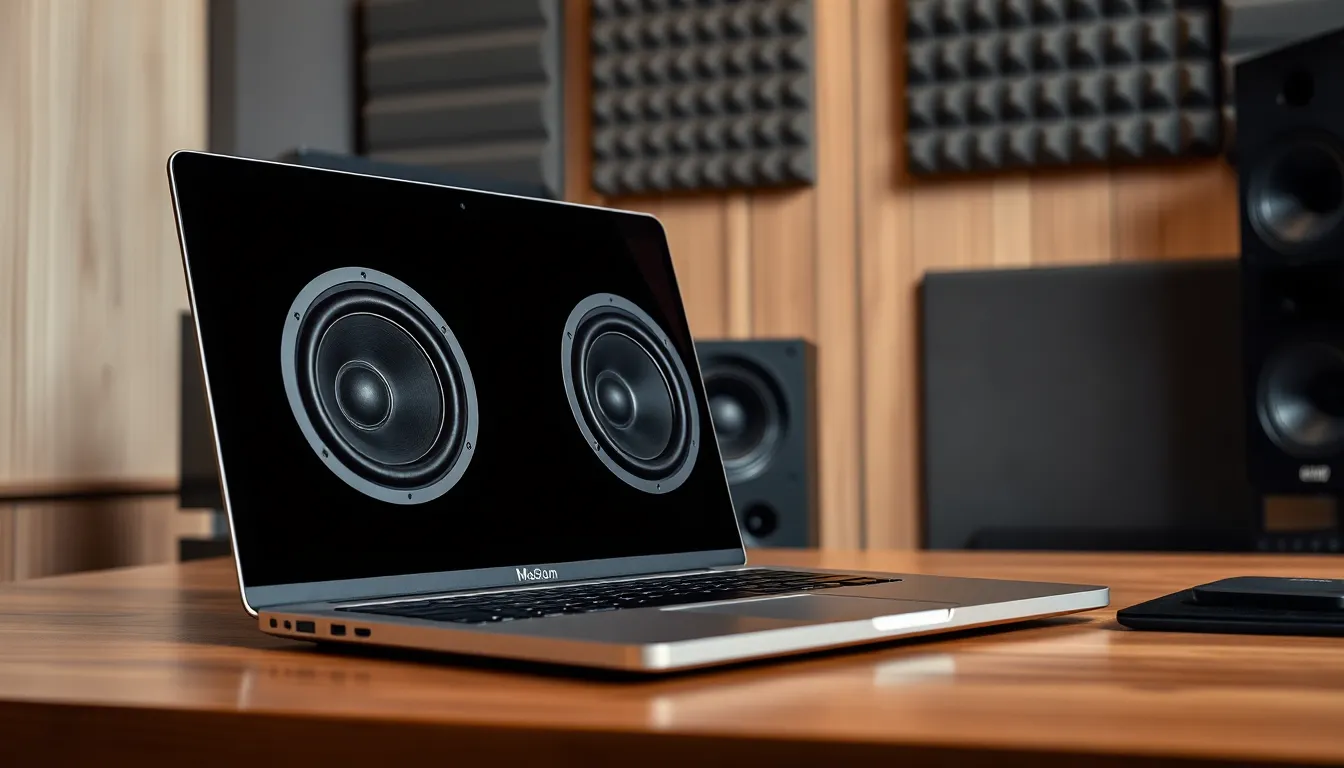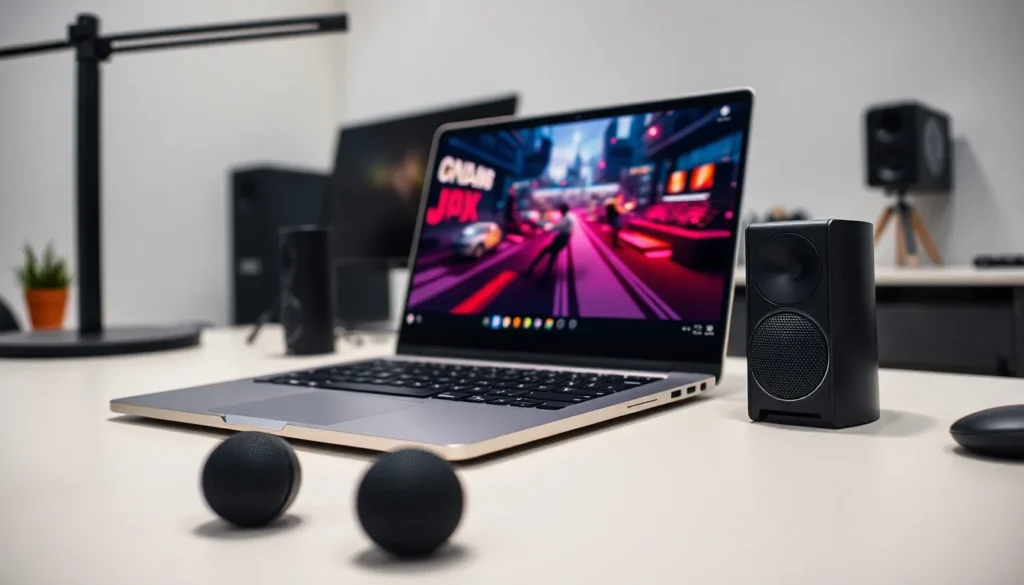Table of Contents
ToggleIn today’s digital world, the audio quality of laptops plays a crucial role in enhancing the user experience. Whether it’s streaming movies, playing games, or attending virtual meetings, clear and immersive sound can make all the difference. Yet, many users often overlook this vital aspect, settling for mediocre audio that fails to deliver.
Understanding the factors that influence laptop audio quality is essential for anyone looking to maximize their listening experience. From speaker placement to software enhancements, various elements come into play. As technology continues to evolve, so do the options for improving sound, making it easier than ever to enjoy high-fidelity audio on the go.
Overview of Laptop Audio Quality
Laptop audio quality refers to the clarity, depth, and richness of sound produced by a laptop’s built-in speakers. Key factors influencing this quality include speaker design, placement, and technology used in sound processing. Modern laptops often feature advancements that enhance audio performance, such as improved hardware components and software optimizations.
Key Factors Affecting Audio Quality
- Speaker Placement: Proper placement enhances sound direction and reduces distortion. Laptops with upward-firing or side-mounted speakers typically deliver better acoustics.
- Audio Drivers: High-quality audio drivers ensure accurate sound reproduction. Drivers optimize audio output based on the laptop’s capabilities and user preferences.
- Sound Enhancements: Digital signal processing (DSP) and equalizers can tailor audio output for different media types. These enhancements allow users to adjust bass, treble, and resonance for an improved listening experience.
Common Audio Formats
Various audio formats influence sound quality. Lossless formats like FLAC and WAV provide higher fidelity, while compressed formats like MP3 may sacrifice some quality for file size. Users should select the format based on their audio needs and playback device.
Usage Contexts
Laptops cater to diverse audio needs. Gamers often prioritize immersive sound for strategic advantages, while professionals may require clear audio for virtual meetings. Streaming enthusiasts benefit from enhanced audio quality for movies and music, enriching overall enjoyment.
technologicaL advancements
Recent technological innovations enhance laptop audio performance. Brands are integrating high-fidelity audio systems and advanced audio solutions, focusing on depth and clarity. Features like surround sound support and soundstage optimization contribute to superior audio experiences across various settings.
Key Factors Influencing Audio Quality

Several key factors determine the audio quality of laptops. Understanding these elements helps users make informed decisions when selecting and using laptop audio systems.
Speaker Quality
Speaker quality directly affects the clarity and richness of sound. High-quality speakers reproduce a wider frequency range, enabling more detailed audio. Larger speaker drivers often generate better bass, while full-range drivers enhance mids and highs. Manufacturers use various materials, such as neodymium magnets, which improve sound efficiency. A well-designed speaker system ensures better sound projection, reducing distortion and enhancing overall listening experience.
Sound Card Performance
Sound card performance influences audio processing capabilities. Integrated sound cards may offer basic features, while dedicated sound cards provide advanced processing power. High-fidelity sound cards support a variety of audio formats and offer digital-to-analog conversion with minimal loss. Enhanced signal-to-noise ratios reduce background noise, improving the overall sound clarity. Users looking for superior audio quality often benefit from laptops equipped with advanced sound cards or those that support external audio interfaces.
Acoustic Design
Acoustic design plays a vital role in audio output. Laptop design affects how sound waves interact within the chassis. Enclosed spaces can amplify certain frequencies, while poor placement may muffle sounds. Manufacturers often utilize sound chambers or vents strategically placed to optimize sound projection. The use of resonant materials also helps minimize unwanted vibrations, contributing to a clearer audio experience. Good acoustic design ensures that sound reproduction remains consistent, regardless of usage scenarios or environmental factors.
Comparison of Laptop Brands
Audio quality among different laptop brands varies significantly, impacting user experience. Examining high-end and budget laptops provides insight into audio performance differences.
High-End Laptops
High-end laptops often emphasize superior audio quality, equipped with advanced components. Brands like Dell XPS, Apple MacBook Pro, and Razer Blade integrate high-fidelity speakers and dedicated sound cards. These laptops typically feature larger driver sizes, enhancing bass response and clarity. For instance, the MacBook Pro offers immersive sound via its six-speaker setup with force-canceling woofers, promoting accurate sound reproduction. Such design elements, combined with professional-grade audio software, elevate the listening experience in gaming and content creation.
Budget Laptops
Budget laptops generally prioritize affordability over audio quality, often resulting in less impressive sound. Brands like Acer Aspire and Lenovo IdeaPad typically contain smaller internal speakers with reduced power and clarity. While these laptops serve casual users, sound may seem flat due to limited bass response. Some budget models, however, incorporate basic sound enhancements. For example, the Acer Aspire 5 uses DTS:X Ultra software, improving sound spatialization. Users seeking optimal audio may consider external speakers or headphones for better performance when using these budget-friendly options.
Tips for Improving Laptop Audio
Optimizing laptop audio significantly enhances overall sound performance. Implementing a few key strategies can maximize audio quality for various activities.
External Speakers
Using external speakers offers a noticeable improvement in sound quality. External speakers can reproduce a broader sound spectrum and provide better bass response compared to built-in options. Wireless Bluetooth speakers, such as those from JBL or Bose, offer portability and ease of use while delivering high-quality audio. For stationary setups, wired speakers from brands like Audioengine or Klipsch provide excellent sound clarity and detail. Connecting an external audio interface can further enhance sound processing, making it suitable for music production or gaming.
Audio Settings Adjustments
Adjusting audio settings can significantly enhance sound quality. Accessing the sound settings in the operating system allows users to fine-tune aspects such as balance, equalization, and spatial sound. Many laptops come equipped with built-in sound enhancement features, such as equalizers and sound modes tailored for specific audio experiences, like gaming or movies. Utilizing software tools or apps, such as Equalizer APO for Windows, enables users to tailor frequencies to personal preferences, enhancing clarity and richness. Regularly updating audio drivers ensures compatibility with the latest audio enhancements and fixes potential performance issues.
Laptop audio quality plays a vital role in enhancing the overall user experience. Users often underestimate its importance, yet investing in a laptop with superior audio capabilities can make a significant difference. By understanding the factors that influence sound quality and exploring options for improvement, individuals can elevate their audio experience.
Whether it’s through high-end models with advanced sound systems or external enhancements like speakers and audio interfaces, there are numerous ways to achieve the best sound possible. Prioritizing audio quality not only benefits gaming and streaming but also ensures clear communication during virtual meetings. Embracing these insights can lead to a more enjoyable and immersive experience with every use.







